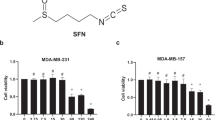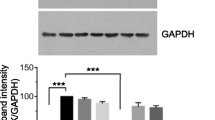Abstract
Signal transducer and activator of transcription 3 (STAT3) is implicated breast cancer metastasis and represents a potential target for developing new anti-tumor metastasis drugs. The purpose of this study is to investigate whether the natural agent 1′-acetoxychavicol acetate (ACA), derived from the rhizomes and seeds of Languas galanga, could suppress breast cancer metastasis by targeting STAT3 signaling pathway. ACA was examined for its effects on breast cancer migration/invasion and metastasis using Transwell assays in vitro and breast cancer skeletal metastasis mouse model in vivo (n = 10 mice per group). The inhibitory effect of ACA on cellular STAT3 signaling pathway was investigated by series of biochemistry analysis. The chavicol preferentially suppressed cancer cell migration and invasion, and this activity was superior to its cytotoxic effects. ACA suppressed both constitutive and interleukin-6-inducible STAT3 activation and diminished the accumulation of STAT3 in the nucleus and its DNA-binding activity. More importantly, ACA treatment led to significant up-regulation of Src homology region 2 domain-containing phosphatase 1 (SHP-1), and the ACA-induced depression of cancer cell migration and STAT3 signaling could be apparently reversed by blockade of SHP-1. Matrix metalloproteinase (MMP)-2 and -9, gene products of STAT3 that regulate cell invasion, were specifically suppressed by ACA. In tumor metastasis model, ACA potently inhibited the human breast cancer cell-induced osteolysis, and had little apparent in vivo toxicity at the test concentrations. ACA is a novel drug candidate for the inhibition of tumor metastasis through interference with the SHP-1/STAT3/MMPs signaling pathway.






Similar content being viewed by others
References
Siegel R, Ma J, Zou Z, Jemal A (2014) Cancer statistics. CA Cancer J Clin 64(1):9–29
Gupta GP, Massague J (2006) Cancer metastasis: building a framework. Cell 127(4):679–695
Redig AJ, McAllister SS (2013) Breast cancer as a systemic disease: a view of metastasis. J Intern Med 274(2):113–126
Steeg PS (2006) Tumor metastasis: mechanistic insights and clinical challenges. Nat Med 12(8):895–904
Wang TH, Niu GL, Kortylewski M, Burdelya L, Shain K, Zhang SM, Bhattacharya R, Gabrilovich D, Heller R, Coppola D, Dalton W, Jove R, Pardoll D, Yu H (2004) Regulation of the innate and adaptive immune responses by STAT-3 signaling in tumor cells. Nat Med 10(1):48–54
Huang SY (2007) Regulation of metastases by signal transducer and activator of transcription 3 signaling pathway: clinical implications. Clin Cancer Res 13(5):1362–1366
Devarajan E, Huang S (2009) STAT3 as a central regulator of tumor metastases. Curr Mol Med 9(5):626–633
Darnell JE Jr (2002) Transcription factors as targets for cancer therapy. Nat Rev Cancer 2(10):740–749
Knoops L, Hornakova T, Royer Y, Constantinescu SN, Renauld JC (2008) JAK kinases overexpression promotes in vitro cell transformation. Oncogene 27(11):1511–1519
Jiao H, Berrada K, Yang W, Tabrizi M, Platanias LC, Yi T (1996) Direct association with and dephosphorylation of Jak2 kinase by the SH2-domain-containing protein tyrosine phosphatase SHP-1. Mol Cell Biol 16(12):6985–6992
Kessenbrock K, Plaks V, Werb Z (2010) Matrix metalloproteinases: regulators of the tumor microenvironment. Cell 141(1):52–67
Xie TX, Wei D, Liu M, Gao AC, Ali-Osman F, Sawaya R, Huang S (2004) STAT3 activation regulates the expression of matrix metalloproteinase-2 and tumor invasion and metastasis. Oncogene 23(20):3550–3560
Dechow TN, Pedranzini L, Leitch A, Leslie K, Gerald WL, Linkov I, Bromberg JF (2004) Requirement of matrix metalloproteinase-9 for the transformation of human mammary epithelial cells by STAT3-C. Proc Natl Acad Sci USA 101(29):10602–10607
Siveen KS, Sikka S, Surana R, Dai X, Zhang J, Kumar AP, Tan BK, Sethi G, Bishayee A (2014) Targeting the STAT3 signaling pathway in cancer: role of synthetic and natural inhibitors. Biochim Biophys Acta 1845 2:136–154
Pandey MK, Sung B, Aggarwal BB (2010) Betulinic acid suppresses STAT3 activation pathway through induction of protein tyrosine phosphatase SHP-1 in human multiple myeloma cells. Int J Cancer 127(2):282–292
Rajendran P, Ong TH, Chen L, Li F, Shanmugam MK, Vali S, Abbasi T, Kapoor S, Sharma A, Kumar AP, Hui KM, Sethi G (2011) Suppression of signal transducer and activator of transcription 3 activation by butein inhibits growth of human hepatocellular carcinoma in vivo. Clin Cancer Res 17(6):1425–1439
Jung JE, Kim HS, Lee CS, Park DH, Kim YN, Lee MJ, Lee JW, Park JW, Kim MS, Ye SK, Chung MH (2007) Caffeic acid and its synthetic derivative CADPE suppress tumor angiogenesis by blocking STAT3-mediated VEGF expression in human renal carcinoma cells. Carcinogenesis 28(8):1780–1787
Ohnishi M, Tanaka T, Makita H, Kawamori T, Mori H, Satoh K, Hara A, Murakami A, Ohigashi H, Koshimizu K (1996) Chemopreventive effect of a xanthine oxidase inhibitor, 1′-acetoxychavicol acetate, on rat oral carcinogenesis. Jpn J Cancer Res 87(4):349–356
Murakami A, Ohura S, Nakamura Y, Koshimizu K, Ohigashi H (1996) 1′-Acetoxychavicol acetate, a superoxide anion generation inhibitor, potently inhibits tumor promotion by 12-O-tetradecanoylphorbol-13-acetate in ICR mouse skin. Oncology 53(5):386–391
Ohata T, Fukuda K, Murakami A, Ohigashi H, Sugimura T, Wakabayashi K (1998) Inhibition by 1′-acetoxychavicol acetate of lipopolysaccharide- and interferon-gamma-induced nitric oxide production through suppression of inducible nitric oxide synthase gene expression in RAW264 cells. Carcinogenesis 19(6):1007–1012
Tanaka T, Kawabata K, Kakumoto M, Makita H, Matsunaga K, Mori H, Satoh K, Hara A, Murakami A, Koshimizu K, Ohigashi H (1997) Chemoprevention of azoxymethane-induced rat colon carcinogenesis by a xanthine oxidase inhibitor, 1′-acetoxychavicol acetate. Jpn J Cancer Res 88(9):821–830
Kawabata K, Tanaka T, Yamamoto T, Ushida J, Hara A, Murakami A, Koshimizu K, Ohigashi H, Stoner GD, Mori H (2000) Suppression of N-nitrosomethylbenzylamine-induced rat esophageal tumorigenesis by dietary feeding of 1′-acetoxychavicol acetate. Jpn J Cancer Res 91(2):148–155
Kato R, Matsui-Yuasa I, Azuma H, Kojima-Yuasa A (2014) The synergistic effect of 1′-acetoxychavicol acetate and sodium butyrate on the death of human hepatocellular carcinoma cells. Chem Biol Interact 212C:1–10
Wang H, Shen L, Li X, Sun M (2013) MicroRNAs contribute to the anticancer effect of 1′-acetoxychavicol acetate in human head and neck squamous cell carcinoma cell line HN4. Biosci Biotechnol Biochem 77(12):2348–2355
Williams M, Tietzel I, Quick QA (2013) 1′-Acetoxychavicol acetate promotes caspase 3-activated glioblastoma cell death by overcoming enhanced cytokine expression. Oncol Lett 5(6):1968–1972
Moffatt J, Kennedy DO, Kojima A, Hasuma T, Yano Y, Otani S, Murakami A, Koshimizu K, Ohigashi H, Matsui-Yuasa I (2002) Involvement of protein tyrosine phosphorylation and reduction of cellular sulfhydryl groups in cell death induced by 1′-acetoxychavicol acetate in Ehrlich ascites tumor cells. Chem Biol Interact 139(2):215–230
Ito K, Nakazato T, Xian MJ, Yamada T, Hozumi N, Murakami A, Ohigashi H, Ikeda Y, Kizaki M (2005) 1′-acetoxychavicol acetate is a novel nuclear factor kappa B inhibitor with significant activity against multiple myeloma in vitro and in vivo. Cancer Res 65(10):4417–4424
Ichikawa H, Takada Y, Murakami A, Aggarwal BB (2005) Identification of a novel blocker of I kappa B alpha kinase that enhances cellular apoptosis and inhibits cellular invasion through suppression of NF-kappa B-regulated gene products. J Immunol 174(11):7383–7392
Ito K, Nakazato T, Murakami A, Ohigashi H, Ikeda Y, Kizaki M (2005) 1′-Acetoxychavicol acetate induces apoptosis of myeloma cells via induction of TRAIL. Biochem Biophys Res Commun 338(4):1702–1710
Pang X, Zhang L, Lai L, Chen J, Wu Y, Yi Z, Zhang J, Qu W, Aggarwal BB, Liu M (2011) 1′-Acetoxychavicol acetate suppresses angiogenesis-mediated human prostate tumor growth by targeting VEGF-mediated Src-FAK-Rho GTPase-signaling pathway. Carcinogenesis 32(6):904–912
Pang X, Yi Z, Zhang X, Sung B, Qu W, Lian X, Aggarwal BB, Liu M (2009) Acetyl-11-keto-beta-boswellic acid inhibits prostate tumor growth by suppressing vascular endothelial growth factor receptor 2-mediated angiogenesis. Cancer Res 69(14):5893–5900
Li C, Yang Z, Zhai C, Qiu W, Li D, Yi Z, Wang L, Tang J, Qian M, Luo J, Liu M (2010) Maslinic acid potentiates the anti-tumor activity of tumor necrosis factor alpha by inhibiting NF-kappa B signaling pathway. Mol Cancer 9:73–85
Chen J, Wang J, Lin L, He L, Wu Y, Zhang L, Yi Z, Chen Y, Pang X, Liu M (2012) Inhibition of STAT3 signaling pathway by nitidine chloride suppressed the angiogenesis and growth of human gastric cancer. Mol Cancer Ther 11(2):277–287
Franke-Fayard B, Waters AP, Janse CJ (2006) Real-time in vivo imaging of transgenic bioluminescent blood stages of rodent malaria parasites in mice. Nat Protoc 1(1):476–485
Ihle JN (1996) STATs: signal transducers and activators of transcription. Cell 84(3):331–334
Schreiner SJ, Schiavone AP, Smithgall TE (2002) Activation of STAT3 by the Src family kinase Hck requires a functional SH3 domain. J Biol Chem 277(47):45680–45687
Hirano T, Ishihara K, Hibi M (2000) Roles of STAT3 in mediating the cell growth, differentiation and survival signals relayed through the IL-6 family of cytokine receptors. Oncogene 19(21):2548–2556
Seidel HM, Milocco LH, Lamb P, Darnell JE Jr, Stein RB, Rosen J (1995) Spacing of palindromic half sites as a determinant of selective signal transducers and activators of transcription (STAT) DNA binding and transcriptional activity. Proc Natl Acad Sci USA 92(7):3041–3045
Han Y, Amin HM, Franko B, Frantz C, Shi X, Lai R (2006) Loss of SHP1 enhances JAK3/STAT3 signaling and decreases proteosome degradation of JAK3 and NPM-ALK in ALK + anaplastic large-cell lymphoma. Blood 108(8):2796–2803
Sandur SK, Pandey MK, Sung B, Aggarwal BB (2010) 5-hydroxy-2-methyl-1,4-naphthoquinone, a vitamin K3 analogue, suppresses STAT3 activation pathway through induction of protein tyrosine phosphatase, SHP-1: potential role in chemosensitization. Mol Cancer Res 8(1):107–118
Wu C, Sun M, Liu L, Zhou GW (2003) The function of the protein tyrosine phosphatase SHP-1 in cancer. Gene 306:1–12
Zhu J, Jia X, Xiao G, Kang Y, Partridge NC, Qin L (2007) EGF-like ligands stimulate osteoclastogenesis by regulating expression of osteoclast regulatory factors by osteoblasts: implications for osteolytic bone metastases. J Biol Chem 282(37):26656–26664
Ostman A, Hellberg C, Bohmer FD (2006) Protein-tyrosine phosphatases and cancer. Nat Rev Cancer 6(4):307–320
Bhutani M, Pathak AK, Nair AS, Kunnumakkara AB, Guha S, Sethi G, Aggarwal BB (2007) Capsaicin is a novel blocker of constitutive and interleukin-6-inducible STAT3 activation. Clin Cancer Res 13(10):3024–3032
Bendell JC, Hong DS, Burris HA 3rd, Naing A, Jones SF, Falchook G, Bricmont P, Elekes A, Rock EP, Kurzrock R (2014) Phase 1, open-label, dose-escalation, and pharmacokinetic study of STAT3 inhibitor OPB-31121 in subjects with advanced solid tumors. Cancer Chemother Pharmacol 74(1):125–130
Gialeli C, Theocharis AD, Karamanos NK (2011) Roles of matrix metalloproteinases in cancer progression and their pharmacological targeting. FEBS J 278(1):16–27
Page-McCaw A, Ewald AJ, Werb Z (2007) Matrix metalloproteinases and the regulation of tissue remodelling. Nat Rev Mol Cell Biol 8(3):221–233
Lu X, Wang Q, Hu G, Van Poznak C, Fleisher M, Reiss M, Massague J, Kang Y (2009) ADAMTS1 and MMP1 proteolytically engage EGF-like ligands in an osteolytic signaling cascade for bone metastasis. Genes Dev 23(16):1882–1894
Orita S, Hirose M, Takahashi S, Imaida K, Ito N, Shudo K, Ohigashi H, Murakami A, Shirai T (2004) Modifying effects of 1′-acetoxychavicol acetate (ACA) and the novel synthetic retinoids Re-80, Am-580 and Am-55P in a two-stage carcinogenesis model in female rats. Toxicol Pathol 32(2):250–257
Park BK, Zhang H, Zeng Q, Dai J, Keller ET, Giordano T, Gu K, Shah V, Pei L, Zarbo RJ, McCauley L, Shi S, Chen S, Wang CY (2007) NF-kappa B in breast cancer cells promotes osteolytic bone metastasis by inducing osteoclastogenesis via GM-CSF. Nat Med 13(1):62–69
Acknowledgments
This work was supported by Grants from the Chenguang Program of Shanghai Municipal Education Commission (10CG25 to X. Pang), the National Natural Science Foundation of China (81101683 to X. Pang), the National Basic Research Program of China (2012CB910401 to M. Liu), and the Fundamental Research Funds for the Central Universities (78260029 to X. Pang).
Conflict of interest
None declared.
Author information
Authors and Affiliations
Corresponding author
Additional information
Jieqiong Wang and Li Zhang have contributed equally to this work.
Rights and permissions
About this article
Cite this article
Wang, J., Zhang, L., Chen, G. et al. Small molecule 1′-acetoxychavicol acetate suppresses breast tumor metastasis by regulating the SHP-1/STAT3/MMPs signaling pathway. Breast Cancer Res Treat 148, 279–289 (2014). https://doi.org/10.1007/s10549-014-3165-6
Received:
Accepted:
Published:
Issue Date:
DOI: https://doi.org/10.1007/s10549-014-3165-6




